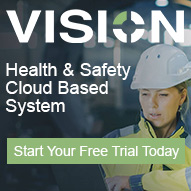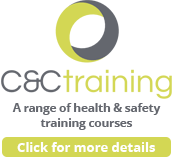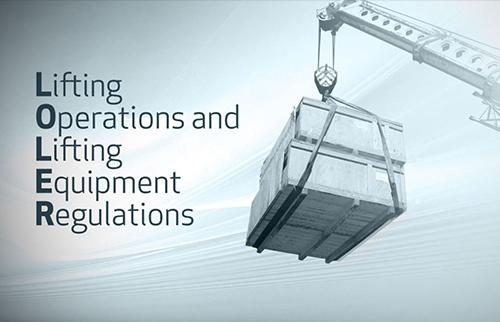Equipment used for lifting a load is subject to stringent statutory and insurance stipulated requirements.
A common finding by our Advisors is the low level of site based workers understanding of the requirements of LOLER, in relation to everyday items used for lifting loads.
If you feel this is the case amongst your employees, to help we have outlined some ‘bitesize snippets’ of terminology out of the regulations to assist in developing your workers’ knowledge and understanding.
What is a lifting operation?
Regulation 8(2) of LOLER defines a lifting operation as ‘an operation concerned with the lifting or lowering of a load’. A ‘load’ is the item or items being lifted, which includes a person or people.
What is lifting equipment?
‘Lifting equipment’ means work equipment for lifting and lowering loads. This includes lifting accessories and attachments used for anchoring, fixing or supporting the equipment
Examples of lifting equipment include:
- overhead cranes and their supporting runways
- patient hoists
- motor vehicle lifts
- vehicle tail lifts and cranes fitted to vehicles
- a building cleaning cradle and its suspension equipment
- goods and passenger lifts
- telehandlers and fork lifts
‘Lifting accessories’ are pieces of equipment that are used to attach the load to lifting equipment, providing a link between the two. Any lifting accessories used between lifting equipment and the load may need to be taken into account in determining the overall weight of the load.
Examples of lifting accessories include:
- fibre or rope slings
- chains (single or multiple leg)
- hooks
- eyebolts
- spreader beams
- magnetic (PDF) and vacuum devices
LOLER is wide in its scope and some equipment might appear to be ‘lifting’ and therefore thought to be covered by LOLER. However, there are some notable exceptions that are not covered by LOLER, including :
- pallet trucks, where the consequence of the load falling off is very low
- roller shutter doors
- escalators
- fall arrest ropes
- tipper trucks
- dentist chairs
However, where this equipment is used at work, it will need to be maintained for safety and may (in some cases) be subject to inspection under PUWER.
Selecting the right equipment
LOLER requires that lifting equipment must be of adequate strength and stability. This adds to the general obligations under PUWER regarding the suitability of work equipment.
Lifting equipment should be positioned or installed in such a way as to reduce the risk, as far as reasonably practicable, of the equipment or load striking a person, or of the load drifting, falling freely or being unintentionally released.
Where people are being lifted, there are additional requirements to prevent people from being injured in / by the carrier, including more frequent thorough examinations.
Marking of lifting equipment
All lifting equipment, including accessories, must be clearly marked to indicate their ‘safe working loads’ (SWL) – the maximum load the equipment can safely lift.
Where the SWL of any equipment or accessory depends on its configuration, the information provided on the SWL must reflect all potential configurations (for example, where the hook of an engine hoist can be moved to different positions, the SWL should be shown for each position). In some cases, the information should be kept with the lifting machinery, e.g. the rated capacity indicator fitted to a crane, showing the operator the SWL for any of the crane’s permitted lifting configurations.
Accessories must also be marked to show any characteristics that might affect their safe use. This may include the weight of the parts, where their weight is significant.
Where equipment is to be used to lift people, it should be marked to indicate the number of people that can be lifted in addition to the SWL of the equipment.
Lifting equipment which is not designed for lifting people – but which might be used this way in error – must be clearly marked to indicate it should not be used to lift people.
Planning, organising and carrying out lifting operations
All lifting operations involving lifting equipment must be:
- properly planned by a competent person
- appropriately supervised, and
- carried out in a safe manner
In planning any lifting operation, the identification and assessment of risk is key to identifying the most appropriate equipment and method for the job. Lifting operations range from:
- the very simple and commonplace, where minimal on-the-job planning by trained, competent people may be all that is needed to manage risk; to
- very complex operations, which require sophisticated and detailed planning / records, with very high levels of expert input, monitoring and supervision – undertaken by specially trained personnel
- The complexity of the plan and the extent of the resources used to manage risk must reflect the complexity and difficulty of the lifting operation.
Thorough examination
Lifting equipment must be thoroughly examined in a number of situations, including:
- before first use (unless there is a valid Declaration of Conformity made less than 12 months earlier)
- where it depends on installation, or re-installation / assembly at another site
- where it is exposed to conditions causing deterioration, liable to result in danger
- Records of thorough examinations should be made and, where defects are identified, they should be reported to both the person using the equipment (and to any person from whom it has been hired or leased), and the relevant enforcing authority (HSE for industrial workplaces; local authorities for most other workplaces).
Lifting accessories must be thoroughly examined before first use and thereafter every 6 months until disposal.
Should you require advice or guidance on your current or developing safe systems of work relating to LOLER, conact C&C Consulting on 01525 309807.











